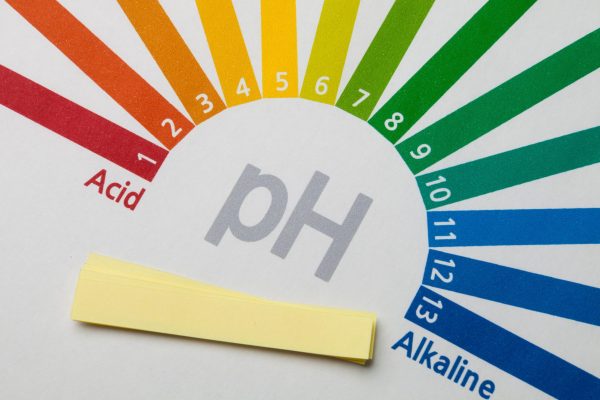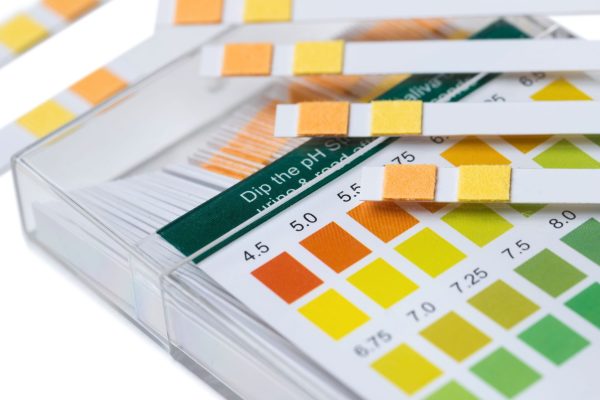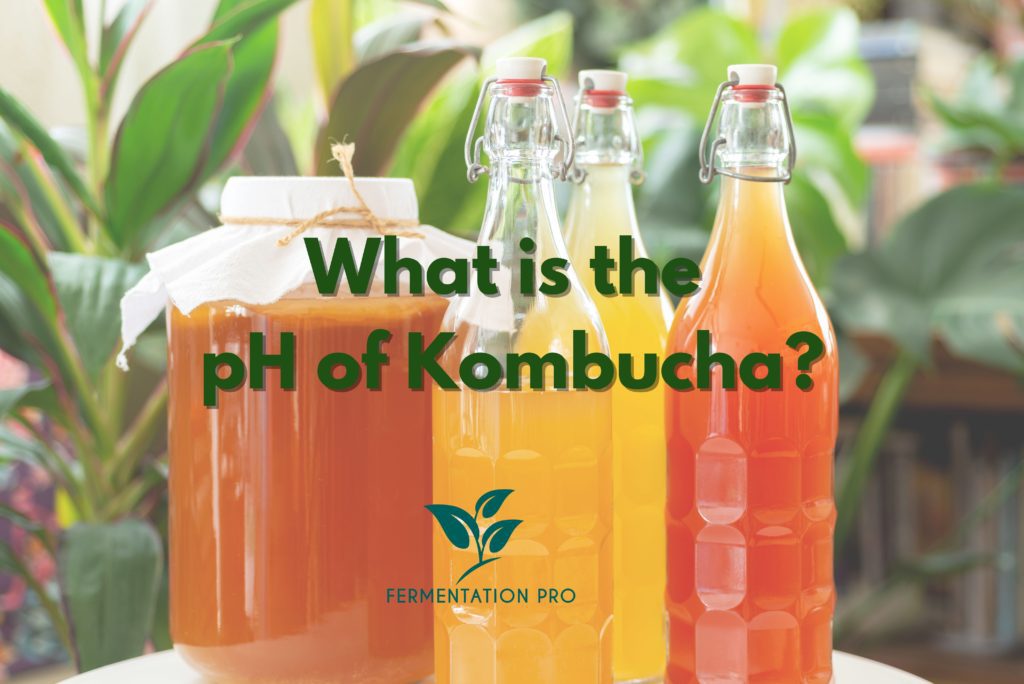As many Kombucha fans already know, Kombucha contains acid that gives this drink its unique tart and sharp flavor. However, not many know its pH level and how acidic this drink really is. Hence, there is no surprise that Kombucha drinkers worldwide are still asking the question, “What is the pH of Kombucha?”
First of all, Kombucha’s pH goes down during the fermentation process so it can be difficult to name an actual pH level. Initially, Kombucha’s pH level is usually at or under 4.5. As the Kombucha further undergoes the fermentation process it becomes more acidic and the finished brew often has a pH that ranges between 2.5 and 3.5.
In this article, we will review further and explain Kombucha’s pH level, ideal pH, and how to test and lower Kombucha’s acidity.
Table of Contents
Is Kombucha Acidic or Alkaline?

Fundamentally, we can say that a solution is acidic when its pH is lower than 7. As we have briefly mentioned above, before fermentation, Kombucha already has an initial pH of 4.5 and lower while the end brew acquires a pH level that ranges from 2.5 to 3.5. These measurements are deemed acidic therefore we can brand Kombucha as an acidic drink.
The metric term pH stands for potential hydrogen. This metric is used to indicate the amount of hydrogen ions a certain substance contains. The pH scale begins from 0, which is translated as the most acidic, to 14, which is deemed most alkaline. Essentially the lower the pH is, the more acidic the substance is.
Solutions that have more than 7 pH are considered alkaline. Meanwhile, solutions that have exactly 7 pH are considered neutral.
What Is the Ideal pH of Kombucha?
The ideal pH of Kombucha before undergoing the fermentation process is below 4.5. On the other hand, the ideal pH for finished Kombucha is between 2.5 to 3.5.
Just like any fermented foods and drinks, Kombucha needs to be acidic to fight off bad bacteria. The pH level below 4.5 is acidic enough to keep your Kombucha brew safe from harmful microorganisms. As a matter of fact, a 2017 Food Code report by the Food and Drug Administration (FDA) affirms that a pH level below 4.6 pH is beneficial for killing bacteria and keeping the food safe for consumption. This pH level does not just fight off the development of bacteria harmful to health but also kills bacteria that may cause spoilage. Therefore, it is necessary that your Kombucha already has a 4.5 pH rating before beginning the fermentation process.
When it comes to the end brew, the ideal pH should be between 2.5 to 3.5 to make sure that it has been properly brewed. Kombucha that has this pH level has the distinct Kombucha tart taste we all love.
You should always check your end brew’s pH because you might over-ferment your Kombucha and drive the pH level to extremely acidic pH levels below 2.0.
What Happens to pH Level of Overfermented Kombucha?
When it comes to the end brew, the ideal pH should be between 2.5 to 3.5 to make sure that it has been properly brewed. Kombucha that has this pH level has the distinct Kombucha tart taste we all love.
You should always check your end brew’s pH because you might over-ferment your Kombucha and drive the pH level to extremely acidic pH levels below 2.0.
The longer you ferment the Kombucha, the higher acidity it can produce. Its higher acidity content is then later translated into low pH or high acidity level.
The longer fermentation gives the yeast in the SCOBY longer time to eat the sugars in your Kombucha and transform them into ethanol. The bacteria in your Kombucha culture then feed on this ethanol, converting it into acids and giving Kombucha its distinctively tart taste.
If you over ferment your Kombucha, there is a huge chance that your finished Kombucha will have a low pH level of around 2.0 or less. In this occurrence, you may need to use your brew for purposes other than drinking. This is because 2.0 pH and lower is considered strongly acidic and may cause several adverse effects, particularly to your teeth. Drinking large amounts of beverages that are too acidic can lead to teeth issues. These include enamel erosion, tooth loss, dentin exposure, sensitive teeth, and increased cavity formation.
In addition, too acidic Kombucha can have a very vinegary taste that could be unpalatable, especially for newbie drinkers.
How to Test the pH of Kombucha
Testing the pH of Kombucha is an essential part of brewing. This helps in making sure that the pH level of Kombucha is within safe levels against the development of harmful microorganisms. Tracking the pH can also help in preventing the Kombucha from over fermenting. It also prevents acquiring too much acidity that could be unappealing for regular consumption.
So, how do you test the pH of Kombucha? Well, believe it or not, it’s very simple. Let’s walk you through it.

What you need to test the pH of Kombucha
To test the pH, you’ll first need to buy pH test strips. pH test strips look like small strips of paper and are widely available in pharmacies and online shops at a very affordable price. They contain a substance that causes the paper to show a different color depending on the acidity or alkalinity level of a solution.
Some people can still get confused between pH test strips and litmus paper. Although both are useful for identifying if a solution is acidic or not, they pose significant differences. pH strips can give the exact pH value of the solution. Litmus paper can only determine whether a solution is acidic or alkaline.
After buying your test strips, you have to take a sample from your Kombucha solution and dip the strip for 2 seconds. Next, wait 10 seconds for the resulting color. Then, you will have to match the pH test strips resulting color to the pH scale. It typically shows 14 different colors. Numbers that go from 0 to 14 with 0 being the most acidic and 14 being the most alkaline.
While pH test strips are considered the most accessible and economical method for testing pH levels, this method may not work for everybody, especially for those who are color blind.
Apart from pH test strips, you can also use a digital pH meter. As its name suggests a digital pH meter is a digital device that measures the pH level of a solution. Just like a pH test strip, you’ll need to dip this device on a solution sample for a couple of seconds. As it reads the pH level, you will see the numbers on its small screen changing. The number automatically stops after taking the accurate pH level. This device offers much accuracy however, it could be relatively expensive.
Whether you opt for a pH test strip or a digital pH meter, you will be able to have a reliable pH reading. Now that you know the methods you can use for testing the pH of Kombucha, let’s get into testing your brew.
Testing the pH of the Kombucha

Essentially, you will need to test your Kombucha’s pH two to three times.
First pH reading
The first pH reading should be taken once you combine all the necessary ingredients for starting your brew. These ingredients include:
- Sweet tea
- SCOBY
- Starter tea
Make sure that the pH is 4.5 below to make sure that no bacteria will thrive in your mixture.
Second pH reading
Although it’s optional, testing your Kombucha after 7 days is a good way to see if your Kombucha is properly brewing. At this point, your Kombucha’s pH should have gone lower. Usually a 7-day-old Kombucha brew has a pH of 3.5 and below.
In addition to testing the pH level, it is also a good measure to consistently taste your brew after 7 days to make sure that you achieve the perfect balance of tart and sweetness that you prefer.
If your Kombucha tastes sweet after 7 days, you can cover and allow your Kombucha to brew longer. Kombucha typically takes between 7 to 21 days to complete fermentation depending on the temperature.
Third pH reading
Continue tasting your brew daily until your preferred balance of sweet and tart is achieved. Once you are satisfied with the taste, you can take your third pH reading. The pH level you get from this reading can serve as your reference for your next brew. This way, you won’t need to taste your next Kombucha batches. Taking your third pH reading also makes sure that your Kombucha is not yet too acidic for regular consumption.
Your Kombucha end brew should have a pH rating between 2.5 and 3.5.
How Do I Lower the pH of Kombucha?
So you want to start brewing your first batch of Kombucha but your sweet tea, SCOBY, and starter mixture’s pH is above 4.5. Well, don’t worry because that is totally fine. When this happens, you can simply add more Kombucha starter to your mixture. A Kombucha starter is basically Kombucha that has completed its fermentation. It contains all the healthy bacteria and yeast needed to kickstart your brew.
Add your Kombucha starter tea and wait for about an hour then test again. Repeat this process until the pH level is 4.5 or lower. Once you have achieved this pH level, you can leave your Kombucha mixture to ferment.
As the fermentation progresses, this pH level should go down further. If your Kombucha’s pH doesn’t go lower, then you may need to extend your brewing time.
What if you went overboard and drove your Kombucha’s pH level to extremely low pH of 2.0 and below? Well, your Kombucha is then considered over fermented and may be too acidic for regular consumption. On a lighter note, there are still a number of ingenious ways to use over fermented Kombucha. You can use over fermented Kombucha as:
- Strong starter tea
- Household cleaner
- Vinegar for cooking
- Salad dressing
- Probiotic water ingredient
If you are still having a hard time figuring out how to use over fermented Kombucha, you can check our guide on the different uses of over fermented Kombucha.








